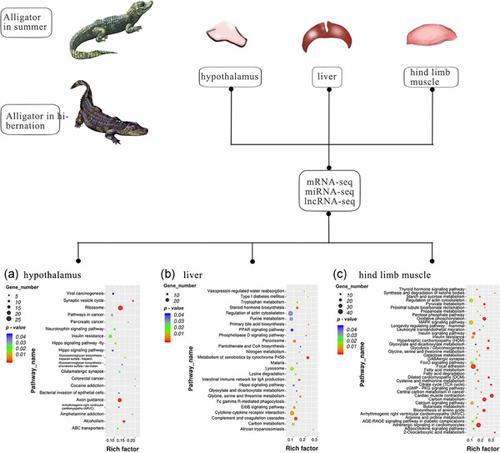当前位置:
X-MOL 学术
›
J. Exp. Zool. B Mol. Dev. Evol.
›
论文详情
Our official English website, www.x-mol.net, welcomes your
feedback! (Note: you will need to create a separate account there.)
Molecular mechanism of Chinese alligator (Alligator sinensis) adapting to hibernation
Journal of Experimental Zoology-B: Molecular and Developmental Evolution ( IF 1.8 ) Pub Date : 2020-11-24 , DOI: 10.1002/jez.b.23013 Jihui Zhang 1, 2 , Ruiqing Cai 1, 2 , Juanjuan Liang 1, 2 , Ali Izaz 1, 2 , Yilin Shu 1, 2 , Tao Pan 1, 2 , Xiaobing Wu 1, 2
Journal of Experimental Zoology-B: Molecular and Developmental Evolution ( IF 1.8 ) Pub Date : 2020-11-24 , DOI: 10.1002/jez.b.23013 Jihui Zhang 1, 2 , Ruiqing Cai 1, 2 , Juanjuan Liang 1, 2 , Ali Izaz 1, 2 , Yilin Shu 1, 2 , Tao Pan 1, 2 , Xiaobing Wu 1, 2
Affiliation

|
Hibernation is a physiological state for Chinese alligators to cope with cold weather. In mammals, gene expression changes during hibernation and their regulatory mechanisms have been extensively studied, however, these studies in reptiles are still rare. Here, integrated analysis of messenger RNA (mRNA), microRNA (miRNA), and long noncoding RNA (lncRNA) reveals the molecular mechanisms of the hypothalamus, liver, and skeletal muscle in hibernating and active individuals. During hibernation, the number of genes increased in the hypothalamus, liver, and skeletal muscle was 585, 282, and 297, while the number of genes decreased was 215, 561, and 627, respectively, as compared with active individuals. Through Gene Ontology and Kyoto Encyclopedia of Genes and Genomes enrichment analysis, the differential expressed genes were mainly enriched in DNA damage repair, biological rhythm, energy metabolism, myoprotein degradation, and other related items and pathways. Besides, 4740 miRNAs were identified in three tissues. Through the comprehensive analysis of miRNA and mRNA abundance profiles, 12,291, 6997, and 8232 miRNA–mRNA pairs all showed a negative correlation in the hypothalamus, liver, and skeletal muscle, respectively. Some miRNA target genes were related tobiological rhythm and energy metabolism, suggesting that miRNA may play an important role in the physiological metabolism of the hibernating adaptability of Chinese alligators. Moreover, 402, 230, and 130 differentially expressed lncRNAs were identified in the hypothalamus, liver, and skeletal muscle, respectively. The targeting relationship of four lncRNA–mRNA pairs were predicted, with the main function of target genes involved in the amino acid transportation. These results are helpful to further understand the molecular regulatory basis of the hibernation adaptation in Chinese alligators.
更新日期:2021-01-19
















































 京公网安备 11010802027423号
京公网安备 11010802027423号